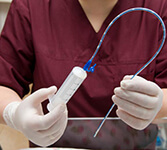Stringent Regulations to Drive Enteral Feeding Devices Worldwide

16 Jul
2016
Enteral feeding tubes are enteral access devices that can be placed directly into the gastrointestinal (GI) tract intended for the delivery of nutrients and drugs into the stomach or intestine. Enteral feeding has long been established medical practice across pediatric and adult populations, mainly to increase nutritional intake. Enteral feeding is preferred to intravenous parenteral feeding for those who have normal functioning GI tracts. Elderly and bedridden patients suffering from various chronic ailments such as cancer, neurological disorders, gastro-intestinal, and certain inherited metabolic diseases contribute to the major demand for enteral feeding devices across regions. Factors that fuel the growth of the market are widespread adoption in home settings and an enhanced popularity of enteral feeding among pediatrics; this is mainly done to help children meet their daily calories’ requirement orally.
Many material suppliers associated with the medical equipment industry incorporate features such as strong chemical resistance while manufacturing enteral feeding appliances. The consistent & accurate delivery of nutritional formula is another concern that impacts the positive perception of patients and their caregivers to adopt high-end feeding devices. In addition, the minimization of errors related with tube misconnection used by enteral feed device manufacturers is a key factors that boost its adoption across various healthcare settings.
View more details about report at: https://www.alliedmarketresearch.com/enteral-feeding-devices-market
New regulations & initiatives ensure safety and accuracy of enteral feeding devices
In order to reduce the frequency of the enteral feeding tube misconnections, an international group of clinicians, manufacturers and regulators, in collaboration with ISO and the Association for the Advancement of Medical Instrumentation (AAMI) have developed ISO 80369 standards. New programs that create awareness in unique international standard designs for enteral feeding devices will foster patient safety and increase the accuracy of the equipment. A program called “Stay Connected initiative” has introduced new standards for using safer connectors. These standards are increasingly being adopted across developed nations. The initiative will gradually help in the introduction of new standard connectors for specific delivery systems, including neuraxial, limb-cuff inflation, and various respiratory applications. The above guideline also ensures that connectors for mismatched delivery systems are incompatible. This has led to the development of standardized connector designs for various specific medical applications so that they cannot be interconnected with devices meant for other medical applications.
The design standards is initially expected to apply for all fluids used in healthcare segment. Eventually the standard will regulate connector shape and size that is used for breathing systems, limb-cuff inflation, driving gases, and intravascular-hypodermic applications.
Furthermore, in an attempt to raise the patient care standards, the market leaders adhere to the ISO standards when manufacturing medical products used with the enteral feeding devices. This considerably reduces the chances of dislodgement, greatly helping physicians and patients.
Market Prospects & Recent Trends
The FDA's latest released guidance in 2015 titled “Safety Considerations to Mitigate the Risks of Misconnections with Small-bore Connectors Intended for Enteral Applications” provides useful recommendations to manufacturers, FDA reviewers, and manufacturers of small-bore connectors that are used for enteral feeding. In addition, this guidance is useful for those submitting or reviewing premarket notification submissions [510(k)s] for enteral feeding devices that use small-bore connectors. This has significantly prevented tubing and luer misconnections in enteral feeding devices leading to enhanced patient safety.
Witnessing immense growth opportunities in the market, Allied Market Research has published a report titled “World Enteral Feeding Devices - Market Opportunities and Forecast, 2014 – 2020”. The global enteral feeding devices market would attain a market size of $2,846.7 million by the end of 2020, growing at a CAGR of 5.6% amid the period 2015-2020. Product launch, acquisition, and increased distribution agreements are some of the key strategies adopted by leading industry players. Based on applications, neurological disorders and cancer are the most dominant indications in the global enteral feeding devices application market. Home enteral nutrition market would exhibit the highest growth amid the forecast period owing to availability of portable and ambulatory enteral feeding devices resulting in the reduction of overall cost for patients and caregivers.

Akhilesh Prabhugaonkar
Author's Bio- Akhilesh Prabhugaonkar holds a bachelor’s degree in Electronics Engineering from the reputed Vishwakarma Institute of Technology. He has a special interest in the fields of forensics, world history, international relations and foreign policy, sports, agriculture, astronomy, security, and oceanography. An ardent bibliophile and melophile, Akhilesh loves to write on topics of his interest and various other societal issues. This love for writing made him enter the professional world of content writing and pursue his career in this direction.
Avenue: Entire Library membership of Allied Market Research Reports at your disposal
- Avenue is an innovative subscription-based online report database.
- Avail an online access to the entire library of syndicated reports on more than 2,000 niche industries and company profiles on more than 12,000 firms across 11 domains.
- A cost-effective model tailored for entrepreneurs, investors, and students & researchers at universities.
- Request customizations, suggest new reports, and avail analyst support as per your requirements.
- Get an access to the library of reports at any time from any device and anywhere.
Related Post
-
Cheese Sauce: How Manufacturing Healthy and Vegan Alternatives Boosts the Potential of Brands?
-
Analyzing the Increasing Preference of Construction Companies for Artistic and Stained Glass
-
How Surface Computing Contributes to the Expansion of Multiple Industries?
-
Air Crane Helicopter: How Advanced Technology Integration Optimizes Operational Efficiency?
-
Which Latest Trends in the Cosmetics Industry Should Businesses Adopt to Stay Ahead of Their Peers?
-
How Are Bicycle Manufacturers Responding to the Evolution in the Gear Bicycle Industry?
-
How Investment in Green Hydrogen Technology Is a Profitable Business Decision?
-
Cash in Transit: How Advanced Telematics Improves the Security of Financial Service Businesses?








